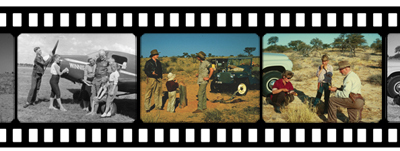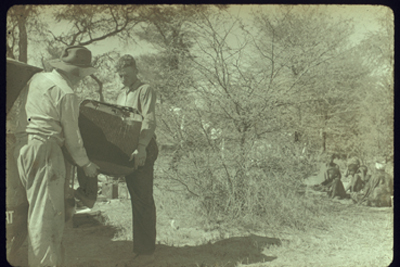
In Part 1, the famed 19th century funambulist, showman and adventurer,
The Great Farini – a.k.a. Bill Hunt from Port Hope, Ontario – discovers
what appears to be the ruins of an advanced civilization in the
unmapped heart of one of the most remote and inhospitable places in
Africa. Part 2 continues the story of a legendary city buried in the
sands of the Kalahari Desert and a Saskatchewan chiropractor’s efforts
to find it.
 |
|
| Left: The Flying Haldemans: Scott, Lynne, Wyn, Joshua, Kaye, Angkor Lee and Maye, 1958. Middle: Kalahari Colours: Joshua and Angkor Lee with a reporter from “Die Transvaaler” newspaper. Right: Wyn, Angkor Lee and Joshua sample desert fare.
|
Dr. Joshua N. Haldeman, DC
Though separated by several generations, Dr. Joshua Haldeman and his countryman had much in common. Like Farini, Haldeman was a restless spirit. Born in 1902 to Almeda Haldeman, the first known chiropractor to practise in Canada, and obtaining his chiropractic credentials in 1926, Haldeman set out at a fast pace to establish himself as a major figure as a chiropractic leader and as a political economist. Practising in Regina, he was the driving force behind obtaining and drafting Saskatchewan’s 1943 Chiropractic Act. He served on the province’s first board of examiners as well as the provincial society’s first executive board and represented Saskatchewan in negotiations leading to the formation of the Dominion Council of Canadian Chiropractors, which was the predecessor body to the Canadian Chiropractic Association. Later, he participated in establishing the Canadian Memorial Chiropractic College, for which he served as a member on the first board of directors. Never one to limit himself to professional activities, Haldeman also chaired the Social Credit Party during the Second World War, subsequently making an unsuccessful run for Parliament and managing to land himself in jail briefly for his political views.1
In 1950, however, he packed up the family and moved to South Africa, a country he had never been to and where he did not know a soul. Citing what he saw as deterioration in the political and moral culture of Canada, it may be closer to the truth that, in middle age, his adventurous spirit was becoming restless for new challenges. It is probably no coincidence that, if challenged, Haldeman could not have come up with another place so near the polar opposite of Saskatchewan’s frozen uniformity to move to. Here he would open a new chapter as an adventurer and explorer, and this is where he and the ghost of The Great Farini would meet.
Atlantis in the desert
It is not clear when Haldeman first encountered the Lost City legend; however, the meeting of the kindred spirits was inevitable. When Farini’s book first appeared there was, surprisingly, not a great deal of public reaction to his “discovery” of the ruins of an apparently highly developed ancient culture in southern Africa far from the classical civilizations of the Mediterranean. Partly this was due to the sheer improbability of the finding, and partly it was due to the near impossibility of anyone verifying the claim. Saying that you had found something in the unmapped Kalahari in 1885 was not far removed, in contemporary eyes, from the more extravagant claims of Victorian spiritualists. In addition, the desert was continuously reinventing itself, dynamically altered by shifting sands and sudden hard rains which can effect transformations and change landscapes overnight. Under such conditions, verification would be difficult at any time. It was as though Farini had found Atlantis in the desert.
Place, truck and foot
The 1920s, however, witnessed renewed interest in Farini’s Lost City and 1949 marked the beginning of a string of attempts to locate the ruins with at least 24 expeditions in the following 16 years where no two years passed without an attempt. Peacock writes that “searches have been conducted on foot, in wagons, trucks, jeeps, Dakota aircraft loaned by the South African Department of Defence and other airplanes.”2 Indeed, at one point, it was purportedly found and lost again through sheer absent-mindedness because the finder did not appreciate its importance or interest.3
 |
|
| Josh and Scott repair a damaged radiator in the Aha Mountains, 1960.
|
Most dogged among Lost City searchers, however, was Haldeman, who led nine expeditions between 1953 and 1965, counting an initial exploratory trip to gather information, and several more afterwards. His search began in earnest in 1957 with an 8,400-mile air-ground search in the area around the Nossob River and followed with ground searches along Farini’s suspected route each year beginning in 1959 and continuing to 1965.4, 5 On every occasion he was accompanied by his wife, Wyn, and those of his children – Scott, Lynne, Maye, Kaye and Angkor Lee – who were around. One Haldeman chronicler reckoned that he was unique in the history of African exploration because he routinely took his whole family with him and two books devoted to attempts to locate the Lost City report extensively on his explorations.6
According to his son Scott, “Josh and Wyn Haldeman carried out sixteen expeditions looking for the Lost City of the Kalahari, most of which included their children. The last was in 1969. These expeditions were into remote areas of what is now Botswana (at the time the Bechuanaland Protectorate). I went on the first six expeditions in 1953, 1957, 1958, 1959, 1960 and 1961 through my school years and before I left South Africa to study. The first expedition was when I was 11 years old and the last at age 18 when I had my driver’s license and drove a Second World War Willy’s Jeep as the second car on that expedition. Prior expeditions had been by a single small truck. Each of these trips lasted approximately one month and was mostly in the bush without a road or even a track. We would go from one area to another using a standard compass and sleeping under the stars in sleeping bags on a tarpaulin.”
Lions, leopards, hyenas and jackals
Life in the bush frequently brought the Haldeman clan into close association with the local wildlife. Haldeman describes one occasion when, upon hearing prowling animals, Wyn spent the night guarding the camp with pistol at hand. “Scott and I were too sleepy to stay awake,” Haldeman remembered, “but … felt perfectly safe with such a good camp guard. She can shoot faster and more accurately than either of us.”7 In the morning, leopard spoor was found all around the camp, yards from where they slept. The youngest, Angkor Lee, routinely slept in the truck to optimize his chances of not being dragged off in the night by large predators.
Scott writes: “We had lions in the camp so close my father could almost touch them. The camps were often surrounded by hyenas, jackals and leopards that would keep the air full of wild sounds. I carried a pistol on my hip most of the time to protect against animals and would often have to ride on top of the truck with a 375 mm Winchester rifle hoping that the truck would flush a buck and I could get in a shot. We only killed animals for the pot, and if we did not kill an animal every few days we had to eat canned sardines. Dad never allowed hunting for hunting’s sake although on one occasion we had to help out a village and hunt a lion that was killing the village goats as he was old and could not hunt wild animals.”
Ki Ki mountain
Perhaps the closest Haldeman came to discovering the site of the ruins was his investigation of the Lost City bearings submitted in Farini’s report to the Royal Geographical Society in 1886. Discovery of the ruins hinged on locating the Ki Ki Mountain described by Farini. According to Clement: “The nearest landmark agreeing with the co-ordinates was situated in an inaccessible and little known district. Led by a guide and the local Kgalagadi chief, Haldeman and his son”, Scott … “ploughed their way through the sand to Bohelo Batu Pan (meaning ‘the people died’) – on to the Kgalagadi village at Manung Pan, which they learnt had been visited by only one other European.” From Manung they proceeded to the specified co-ordinates. “Although the surrounding country fitted Farini’s description of the Lost City area, there were no signs of ruins.”8
Though Haldeman never did locate the Lost City, he remained convinced of its existence. For Haldeman, Farini’s story simply felt right. He based much of his belief on first-hand knowledge: many expeditions into the Kalahari convinced him that Farini had actually been in the places he wrote about. He found Farini’s descriptions accurate and his comments about his surroundings convincing and continued to find locals who recognized depictions of the ruins.9 He stated unequivocally in an account of his aerial search in The South African Archaeological Bulletin that “someday the Lost City of the Kalahari will be found”10 and, in a letter to one of Farini’s descendants, “We do not feel he made the ‘Lost City’ up as we have confirmed everything else in the book.”11 After 1969, however, Haldeman’s rotating gaze fixed on other priorities and the search for the Lost City was not continued.
Epilogue
Farini retired to his home town of Port Hope, Ontario, where he continued to amaze his neighbours with his creativity and energy until he died in 1929 at the ripe age of 90. Dr. Joshua Haldeman became an important figure in the South African chiropractic community and counted a former president and several cabinet ministers among his patients. An accomplished aviator, Haldeman flew extensively throughout Africa, Europe and Australia, and was killed in a plane crash in 1974. His son Scott also went on to become a chiropractor. He is currently clinical professor in the Department of Neurology at the University of California, Irvine, and adjunct professor Department of Epidemiology, in the School of Public Health at the University of California at Los Angeles and holds an MD and PhD in addition to his chiropractic degree. Angkor Lee was not eaten by large predators and is currently associate vice-president, academic development, SAIT Polytechnic in Calgary.
As for the Lost City itself, some have suggested that the sculpted features Farini encountered are similar to the naturally occurring dolorite formations in the area around Reitfontein and that the material which he took for cement was characteristic of the weathering of the calcium-rich rock. When combined with a showman’s imagination, such geologic formations could be interpreted as the remnants of a cyclopean structure. On the other hand, Troy was also thought to be mythical until its immense riches were unearthed by Heinrich Schliemann in 1873.
But that’s another story.
REFERENCES
1. Keating, Joseph
C. Jr. and Scott Haldeman, Joshua N Haldeman, DC: the Canadian Years,
1926-1950, J Can Chiropr Assoc. 1995 September; 39(3): p. 172.
2.
Peacock, Shane. The Great Farini: The
High-Wire Life of William Hunt. Toronto,
Viking, 1995: p.349.
3. Editor’s Note in Haldeman, J.N., Lost City of the Kalahari, The South
African Archaeological Bulletin, 1958 March; 13 (49): p. 40.
4.
Clement, A. John. The Kalahari and Its
Lost City. Cape Town,
Longmans, 1967: p. 195-196.
5.
Haldeman, J.N., Lost City of the Kalahari,
The South African Archaeological Bulletin, 1958 March; 13 (49): pp,
39-40.
6.
Clement, A. John. The Kalahari and Its
Lost City. Cape Town,
Longmans, 1967.
7.
Goldie, Fay. The Lost City of the Kalahari: The Farini Story and Reports on
Other Explorations. Cape Town,
A.A. Balkema, 1963: p. 12.
8. Clement, A. John. The Kalahari and Its Lost City. Cape Town, Longmans, 1967: p. 110.
9.
Peacock, Shane. The Great Farini: The
High-Wire Life of William Hunt. Toronto,
Viking, 1995: p.353.
10.
Haldeman, J.N., Lost City of the Kalahari,
The South African Archaeological Bulletin, 1958 March; 13 (49): p. 40.
11.
Peacock, Shane. The Great Farini: The
High-Wire Life of William Hunt. Toronto,
Viking, 1995: p.354.
Print this page